Eastern Bristlebird
Eastern BristlebirdDasyornis brachypterus | |
|---|---|
| Kingdom: | Animalia |
| Phylum: | Chordata |
| Class: | Aves |
| Order: | Passeriformes |
| Family: | Dasyornithidae |
| Status | |
| World: | Endangered IUCN Red List |
| Australia: | Endangered EPBC Act Listed |
| Victoria: | Critically Endangered (FFG Threatened List 2025) |
| FFG: | Listed |
| Profiles | |
| Victoria: | FFG Action Statement 89 |
| Australia: | National Recovery Plan |
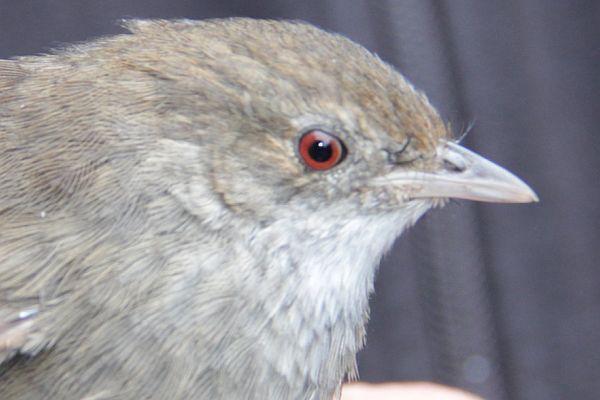
The Eastern Bristlebird is a small ground dwelling bird found only in Australia. It is rarely seen flying in the open, preferring a dense ground layer of vegetation in which to seek shelter and feed. It has two small bristles near the base of its bill.
There are three related species of Bristlebird in the genus Dasyornis endemic to Australia;
- Eastern Bristlebird Dasyornis brachypterus - (far eastern Victoria, New South Wales and Queensland).
- Rufous Bristlebird Dasyornis broadbenti - (Anglesea to south-east South Australia).
- Western Bristlebird Dasyornis longirostris (Western Australia).
The Eastern Bristlebird is slightly smaller than the introduced Blackbird. It is described as being a small, well-camouflaged, ground-dwelling bird. It is dark cinnamon-brown above, with pale colouring around the eyes and base of the bill, an off-white chin and throat, and a rufous-brown panel on each wing. It is greyish-brown below, with an off-white centre to the belly. It has red to red-brown irises, an off-white to pinkish-white gape, and pinkish-brown legs and feet (Higgins and Peter 2002).
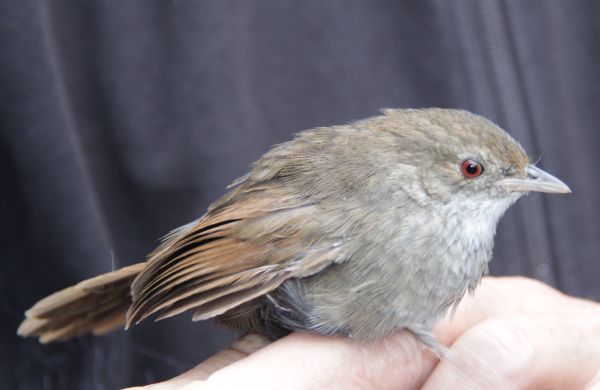
Distribution
Across its range in south-eastern Australia, the Eastern Bristlebird has contracted to four isolated populations within three main regions;
- Northern population - south-eastern Queensland/north-eastern NSW.
- Central populations - Illawarra and Jervis Bay regions of eastern NSW.
- Southern population - New South Wales / Victorian border coastal region.
Source: OEH 2012.
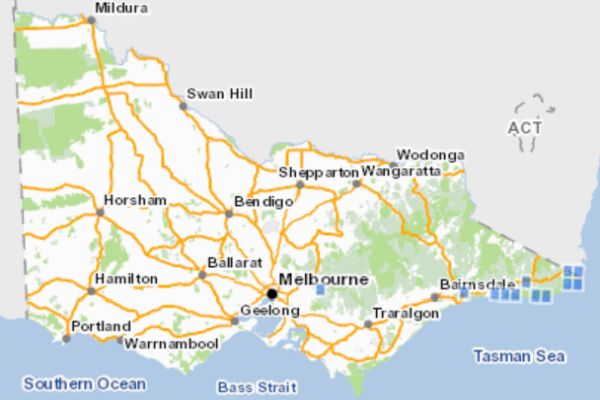
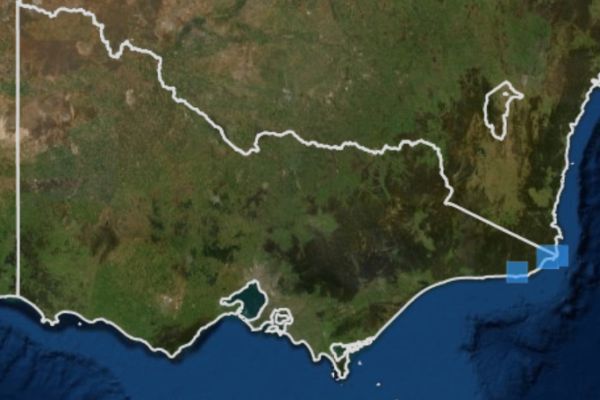
Eastern Bristlebird records 2010 - 2018. Source VVB 2020.
Between 2010 to 2020 the Victorian population has contracted to one location at Howe Flat near Mallacoota.
Ecology & Habitat
The Eastern Bristlebird inhabits low, dense, ground or understorey vegetation. In Victoria, its geographic distribution is in the far eastern section of Croajingolong National Park, particularly in Riparian Scrub Complex and Wet Heathland EVCs dominated by Melaleucas, Tea-trees and other heath species with a sedge understorey.
Life span/breeding
The Eastern Bristlebird can live for 4-6 years, it is regarded as a ground nesting species using tussocks and sedges which provides limited protection from introduced predators. Breeding usually takes place from August to February.
Feeding
The Eastern Bristlebird is predominately a ground feeding bird, diet consists mainly on invertebrates found in the soil, leaf litter and around logs and branches which support a diverse range of invertebrates e.g. worms, and a variety of insects. It is also known to feed on seeds and small fruits of grasses and other plants.
Movement
The average overlapping home ranges of pairs is estimated to be about 10 hectares (Baker 2001). At Howe Flat, a population density of 1.5-2 birds/10ha were recorded (Bramwell 2008).
Source: (OEH 2012).
Population Status
The conservation status of Eastern Bristlebird was re-assessed from Endangered in 2013 (DSE 2023) to Endangered in 2020 as part of the Conservation Status Assessment Project – Victoria (DELWP 2020).
In 2012, the total national population of the Eastern Bristlebird was estimated to be approximately 2500 birds. In Victoria, surveys between 1997-2002 estimated only 120-140 birds in suitable habitat in the Howe Flat area of Croajingalong National Park (Bramwell 2008). New surveys will be required to determine the Victorian population after the devastating 2020 bushfires in East Gippsland.
Threats
Loss or fragmentation of suitable habitat
Given the Victorian population is within the Croajingolong National Park its habitat is reasonably secure except for detrimental fire events.
Fire events
The National Recovery Plan 2012 states ‘The Southern population is vulnerable to local extinction because of its small size and the high likelihood of widespread catastrophic fire’. The Victorian Flora & Fauna Guarantee Scientific Committee (SAC 1994) raised the possibility of extinction due to catastrophic fire.
Predation
Introduced feral predators such as cats, foxes, rats, dogs and pigs are considered to have a high impact on populations and significantly more impact than native predators e.g. raptors in the natural ecosystem.
Increased predation after fire events has been raised as an issue as it allows easier access for feral animals to impact on Bristlebirds due to loss of ground cover/loss of shelter.
Genetics
As the populations of Eastern Bristlebirds have contracted into discrete genetic units with low numbers in areas such as Howe Flat, Victoria, the issue of genetic viability comes into question.
A full description of threats is elaborated in the National Recovery Plan 2012.
Climate change
With the impacts of a changing climate now apparent in Victoria in terms of an increase of up to 1.40 higher than normal maximum temperatures in occurring since 1998 and decreased rainfall in south-eastern Australia, Eastern Bristlebird habitat is likely to be degraded. For the Bristlebird, climate change can impact on increased risk of fires, changes in vegetation, reduced food source and possible reduction in reproductive success. Given the low-lying nature of the habitat at Howe Flat (0-5m), rising sea levels also present a threat to the species.
Climate change data (BOM 2020).
Conservation & Management
These objectives and implementation measures are further detailed in the National Recovery Plan 2012.
OBJECTIVE 1: Maintain and improve the condition and extent (carrying capacity) of Eastern Bristlebird habitat and minimise known or likely threats for all populations, with particular emphasis on fire prescriptions, minimising habitat fragmentation and control of: feral predators, exotic herbivores, overgrazing and weeds.
OBJECTIVE 2: Undertake survey, monitoring and mapping to improve knowledge of all Eastern Bristlebird populations. Population dynamics and National Recovery Plan for Eastern Bristlebird Dasyornis brachypterus Page 34 of 74 habitat condition will be monitored in each population. Methods including survey effort and frequency will be reviewed and standardised and will be subject to ongoing review according to census results or special circumstances such as wildfire. Potential habitat will be surveyed to potentially locate new colonies in the northern and southern populations, and to estimate more accurately the population size for all populations.
OBJECTIVE 3: Enhance/augment northern and southern populations, building towards viable populations as determined by population viability analysis.
OBJECTIVE 4: Conduct research to increase knowledge of ecology, threats and habitat management requirements of the Eastern Bristlebird.
OBJECTIVE 5: Increase community awareness, understanding and involvement in the Eastern Bristlebird recovery effort, particularly on private land. Improve communication between working groups and stakeholders including Australian and State Government agencies, CMAs and other NRM bodies, the Aboriginal community, landholders, land managers, rural fire services and interest groups.
OBJECTIVE 6: Effectively organise and administer the recovery effort to ensure that recovery plan objectives are met.
Projects & Partnerships
Eastern Bristlebird emergency rescue mission February 2020, Eastern Victoria
A mission to save the last known population of Eastern Bristlebirds in Victoria was planned and executed by DELWP, Parks Victoria and Zoos Victoria during the first week of February 2020.
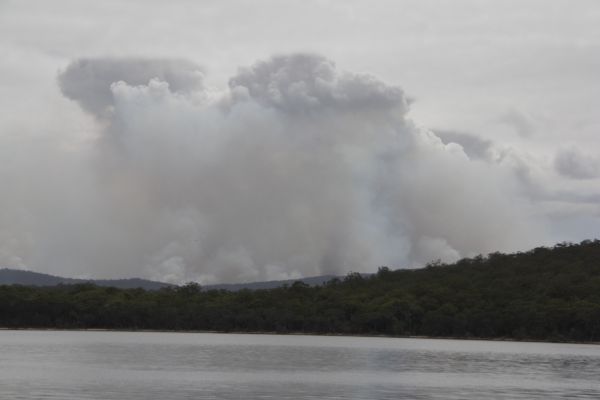
Catastrophic fires burning in East Gippsland during January/February 2020 threatened the last population of Eastern Bristlebirds in Victoria. Image courtesy T. Mitchell.
The objective of the rescue plan was to capture and house up to 20 Eastern Bristlebirds at Zoos Victoria as an insurance against the threat of the bushfire emergency with the intention of returning the Bristlebirds back to their natural habitat when it is safe to do so.
The urgent need to act was in response to ongoing fire in the immediate area and knowledge that this population of birds was only one of four populations of the Eastern Bristlebird, the others being in New South Wales and Queensland. Saving this population was regarded a crucial to maintaining the bird’s genetic diversity and therefore its continued survival.
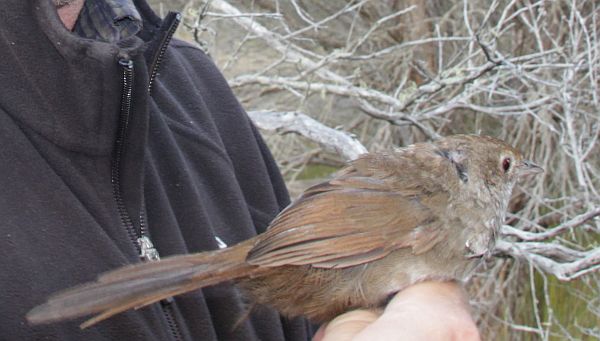
Dr Rohan Clarke - Monash University, holds an Eastern Bristlebird saved from fires and given a chance to reinvigorate the population upon release when it is safe to do so. Image: T. Mitchell.
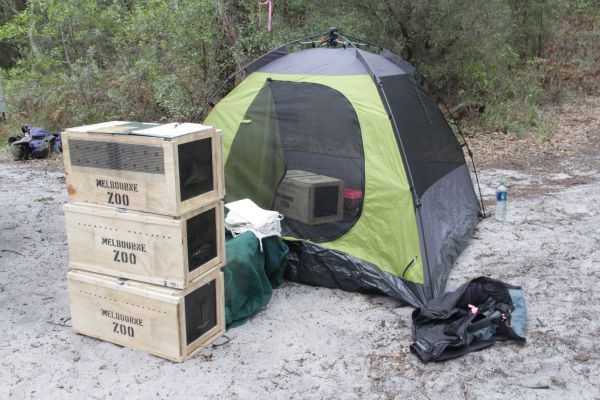
Processing in the field - the team of experts involved in capturing and transporting the Eastern Bristlebirds comprised DELWP, Parks Victoria, Zoos Victoria, Currumbin Sanctuary, Fisheries Victoria and Monash and Wollongong universities. Image: T. Mitchell.
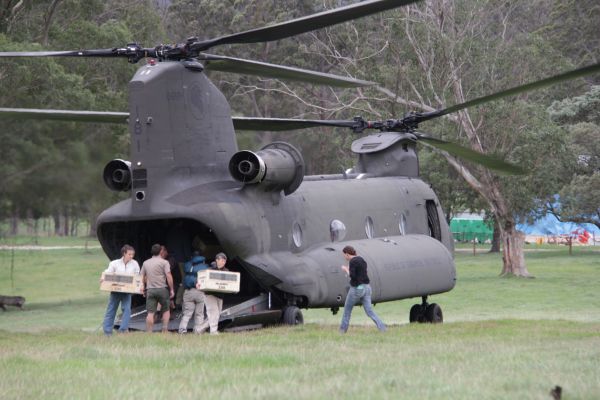
Due to the remoteness and inaccessibility of the area due to fires a Singapore Defence Force Chinook helicopter was used to transport the team of experts to Howe Flat. The captured birds were transported to Melbourne Zoo in daily fixed-wing flights from Mallacoota. Image: T. Mitchell.
See also: January 2020 bushfires and biodiversity East Gippsland and North East Victoria
wildlife.vic.gov.au Expert team fly in to rescue threatened bird from bushfires 6 February 2020
References & Links
Baker, J. (2001) Population density and home range estimates for the Eastern Bristlebird at Jervis Bay, south-eastern Australia. Corella 25:62-67.
BOM (2020) Australian Bureau of Meteorology, Rainfall anomaly, Temperature anomaly.
Bramwell, M.D. (2008) The Eastern Bristlebird Dasyornis brachypterus in East Gippsland, Victoria, 1997–2002. Australian Field Ornithology 25: 2–11.
DELWP (2020) Provisional re-assessments of taxa as part of the Conservation Status Assessment Project – Victoria 2020, Department of Environment Land Water and Planning, Victoria. Conservation Status Assessment Project – Victoria
FFG Threatened List (2025) Flora and Fauna Guarantee Act 1988 - Threatened List - March 2025, Department of Energy, Environment and Climate Action (DEECA) , Victoria.
Higgins, P.J. and Peter, J.M. (eds.) (2002), Handbook of Australian, New Zealand and Antarctic Birds Volume 6: Pardalotes to Shrike-thrushes. Oxford University Press, Melbourne, pp 95-107.
IUCN (2020) BirdLife International 2016. Dasyornis brachypterus . e.T22704507A93972785.The IUCN Red List of Threatened Species 2016: Downloaded on 11 February 2020.
OEH (2012) National Recovery Plan for Eastern Bristlebird Dasyornis brachypterus. Office of Environment and Heritage, Department of Premier and Cabinet (NSW), Sydney.
SAC (1994) Final recommendation on a nomination for listing: Dasyornis brachypterus Eastern Bristlebird (Nomination 284). Scientific Advisory Committee, Flora and Fauna Guarantee. Dept. of Conservation and Natural Resources, Victoria.
VVB (2020) Visualising Victoria's Biodiversity map portal.
More Information
Eastern Bristlebird - Species profile & threats database, Australian Government
Eastern Bristlebird - Office of Environment & Heritage, New South Wales
Eastern Bristlebird - Department of Environment & Science, Queensland
Eastern Bristlebird - SWIFFT Seminar Notes - Emergency rescue project 2020
See also: Rufous Bristlebird
Please contribute information regarding Eastern Bristlebird in Victoria - observations, images or projects. Contact SWIFFT

